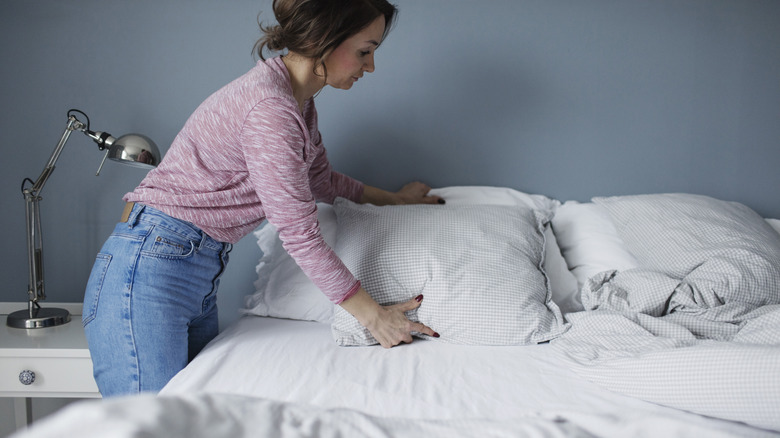This Controversial Pillow Cleaning Method Has Everyone In Hot Debate
Have you ever wondered why we have an entire season dedicated to deep cleaning? Tradition aside, one practical reason could be to take advantage of the increasingly longer, sunnier days in spring. Proponents of pillow sunbathing — which, by the way, includes everyone from clean-obsessed IGers to pillow manufacturers — stand by benefits like disinfection, odor reduction, whitening, and pest elimination. However, a few experts claim that some, if not all, pillow materials will deteriorate in the sun. Is failing to sun the soft cloud you lay your head on every night the pillow washing mistake you might be guilty of on laundry day? Or are you doing the right thing by taking it to the dry cleaner?
"The sun's UV rays are actually proven to reduce bacteria, which is great, as a sweat-covered pillow can be a breeding ground for bacteria," says Jessica Hanley, the founder and CEO of luxury bedding supplier Piglet in Bed, via TechRadar. It's a specialist claim that is, in fact, backed by science. UV light exposure, which comes from the sun (as well as artificial sources), is well known to kill microbes — from bacteria to viruses — even indoors through windows, as an oft-cited 2018 study published in Microbiome confirms. It's not hard to believe sunlight would clear a pillow of bacterial build-up. However, it's not a foolproof method. Midday summer sun works best, and a lot of it, according to a 2020 paper published in Air Quality, Atmosphere & Health. Even then, the sun probably won't destroy every microscopic baddie. Anywhere the sun doesn't reach, like creases and folds, or if you forget to flip over your pillows, won't be decontaminated.
How to bake in the benefits of sunbathing your pillows
Sun exposure can remove that musty smell pillows get after washing or from general use. Since this is often referred to as "airing," it's hard to know whether the sun or the fresh summer breeze is responsible for the deodorizing. Some cleaning professionals also claim the sun whitens pillows and bleaches stains, though that action is more anecdotal than proven. Direct exposure to sunlight can be helpful for those dealing with infestations of the macroscopic variety. Clothes moths, carpet beetles, scabies mites, and their larvae won't survive sunbathing. Dust mites won't fare well, either, though the sun won't remove the allergen itself — their poop.
Convinced? Learning how to care for and clean your bed pillows using the sun couldn't be easier. Hang or lay the pillow someplace off the ground, in full sun, and well-ventilated for anywhere from half an hour to a couple of hours. Turn the pillow every 30 minutes to two hours, fluffing the stuffing or feathers. Don't have any outside space? Laying the pillow in a patch of sunlight streaming in through a window works, too. If humidity is high, you risk mold; skip pillow sunbathing that day or week. Note, too, that some pillow manufacturers advise against putting their pillows in the sun, so check the instructions that came with your pillow before popping it outdoors exposed. The material memory foam and latex pillows are made from can deteriorate if they come into contact with direct sunlight. If you hope to pop your pillows in the sunshine from time to time, consider this when picking pillows for your bed.
